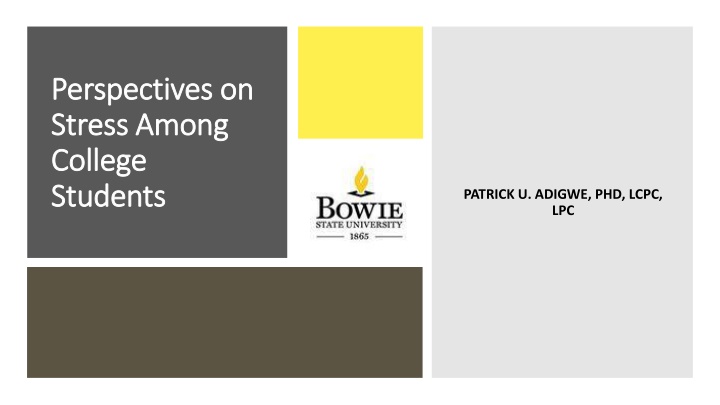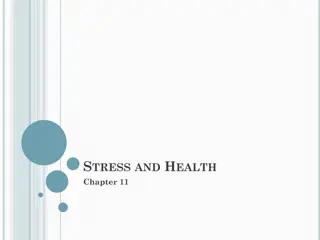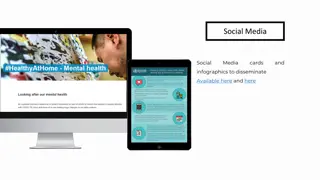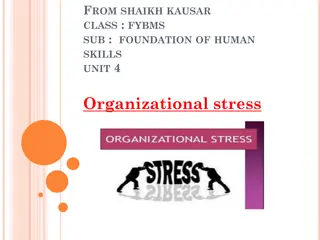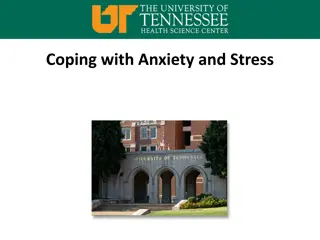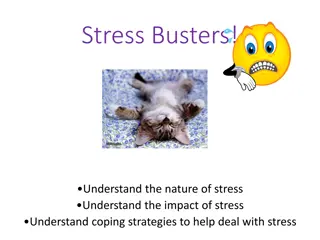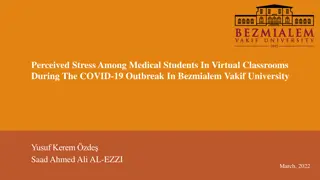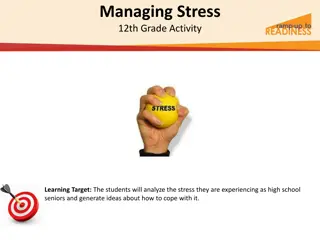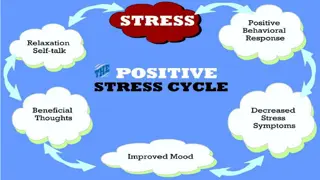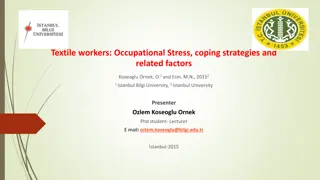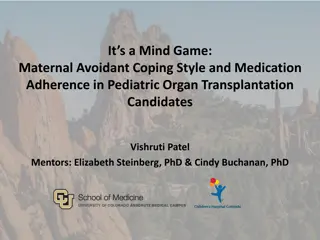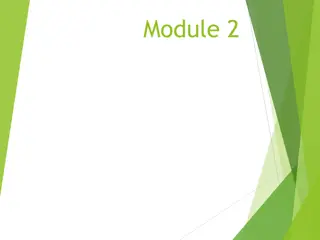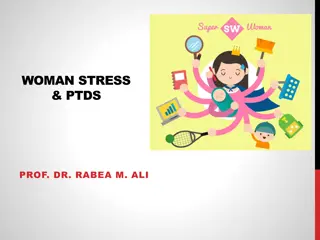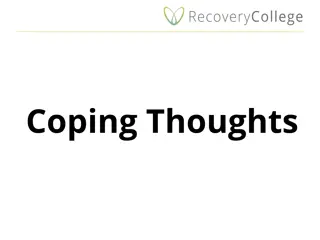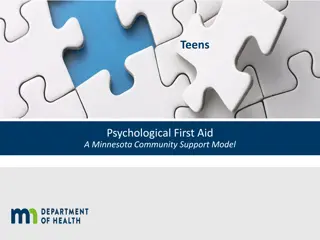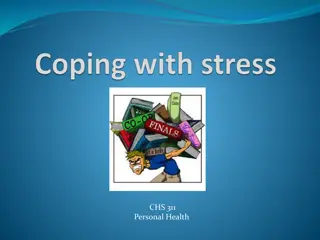Insights into College Students' Stress Levels and Coping Mechanisms
Stress among college students, especially freshmen and sophomores, was explored in a study focusing on factors contributing to stress levels. The research examined differences based on gender and educational level, aiming to understand the distinctions in stress experiences among students. Various stressors impacting college students, including academic, social, family, and personal aspects, were highlighted. The study sample comprised African-American and Caucasian undergraduate students in Washington D.C., providing valuable insights into the complexities of stress in higher education settings.
Download Presentation

Please find below an Image/Link to download the presentation.
The content on the website is provided AS IS for your information and personal use only. It may not be sold, licensed, or shared on other websites without obtaining consent from the author.If you encounter any issues during the download, it is possible that the publisher has removed the file from their server.
You are allowed to download the files provided on this website for personal or commercial use, subject to the condition that they are used lawfully. All files are the property of their respective owners.
The content on the website is provided AS IS for your information and personal use only. It may not be sold, licensed, or shared on other websites without obtaining consent from the author.
E N D
Presentation Transcript
Perspectives on Perspectives on Stress Among Stress Among College College Students Students PATRICK U. ADIGWE, PHD, LCPC, LPC
Past Research Publications Introduction Statement of the Problem Purpose of the Study Significance of the Study Research Questions Research Hypothesis Instrumentation Demographics Research Results Conclusion and Recommendation Limitations of the Study Proposed Future Research References Overview Overview
Adigwe, P. (2020). The Impact of Attention- deficit/hyperactivity disorder among African American children: Examination of cultural Disparities associated with Diagnosis and Treatment in mental health. (Submitted for Publication). Orkoro, E. & Adigwe, P. (2018) Therapeutic Communication and Client Counseling Toward a Conceptual Framework for Strategic Interpersonal Engagement. International Journal of Business and Social Sciences Vol. 9. No 6. June 2018 doi:10.30845/ijbss.V9n6pl Adigwe, P. & Okoro, E. (2016) Human Communications and Effective Interpersonal Relationships: An Analysis of Client Counseling and Emotional Stability. Int J Econ Manag Sci 5:336. doi:10.4172/2162-6359.1000336 Adigwe, P. (2014). Perspectives of Stress among College Students. VDM Verlag Dr. Muller Aktiengellschaft & Co. KG. Adigwe, P. (2004). An Examination of the relationship of Stress, gender and academic year among Public Community College Students. Howard University Dissertation. PUBLICATIONS PUBLICATIONS
The present study examined the differences between gender and educational level of students (freshman and sophomore) in the amount of stress they experience. It further sought to understand what distinguishes levels of stress among college students. This study attempted to look at factors that contribute to stress among college students. The population for this study consisted of African-American, Caucasian male and female undergraduate students attending a college in the Washington D. C. Metropolitan area. The sample consisted of 62 freshman and sophomore students. The students were recruited from Psychology and Biology classes. All the participants were between 18 and 28 years. INTRODUCTION INTRODUCTION
Stress is the act, condition, or effect of exerting force on someone or something (Brower, 1990). According to Brower (1990), undue stress has the effect of slowing an individual down, both mentally and physically. People vary considerably in their abilities to handle stress. Zitzow (1994) suggested that such simple behaviors as talking, or crying can give an outlet to restrained emotions. College students are affected by stress on a regular basis. According to Zitzow (1994), all four student environments: academic, social, family, and personal seemed to have an impact on the student s stress experience and adjustment within the school environment. According to Greenberg (1990), younger college students who enter college immediately after high school or shortly afterward experience stressors such as the dramatic lifestyle change from high school to college, grades, course overload, making friends, love and sex stressors, shyness, jealousy, and break-ups. STATEMENT OF THE STATEMENT OF THE PROBLEM PROBLEM
The purpose of the study was to examine how gender and educational level of students (freshman and sophomore) differ in the amount of stress they experience. It further sees to understand what distinguishes levels of stress among freshman and sophomore college students. PURPOSE OF PURPOSE OF THE STUDY THE STUDY
This study represented an important contribution to the psychological literature on stress among college students. Understanding the sources of stress and developing effective stress management strategies is a prerequisite for preparing students for success in life and future careers (Sharpley & Scuderi 1990) or for any other future endeavor. Research indicates a high risk of immediate and long-term harm due to stress for college students (Brower, 1990). The prevention of such harm is considered to be the ethical responsibility of the college and university system (Smallman, Sowa & Young, 1991). This study seeks to provide information that will help guide counselors within college and university settings to develop and implement stress reduction programs. SIGNIFICANCE SIGNIFICANCE OF THE STUDY OF THE STUDY
Are there differences in the perceptions and experiences of stress for freshmen and sophomore college students as measured by Brief Personal Survey? Are there differences in the perceptions of stress between female and male freshman and sophomore college students as measured by the Brief Personal Survey? Are there differences in the sources of stress between freshmen and sophomore college students as measured by the Stressor Checklist? RESEARCH RESEARCH QUESTIONS QUESTIONS
There will be no significant difference between freshmen and sophomore college students in the amount of stress experienced as measured by Brief Personal Study. There is no difference between female and male freshman college students as measured by the Brief Personal Survey. There are no perceived significant differences in the sources of stress between freshman and sophomore college students as measured by the stressor. RESEARCH RESEARCH HYPOTHESES HYPOTHESES
The first instrument was the standardized Brief Personal Survey (BPS) Webb (998). The BPS consisted o f 80 True/False items. Items were written on a sixth-grade reading level and were designed to be answered by personas from teenage to senior adult years. The second instrument was a checklist of the sources of stress which were compiled by the research on the basis of the literature review. Each stress source was presented on a five-point Likert scale ranging from 1-Not stressful to 5-Extremely stressful. Respondents were asked to indicate to what extent they have personally experienced each stressor in the previous six months period. Descriptive statistics which were used to report characteristics of the sample as they related to the variable examined. At t-test of independence sample for gender with a probability level of .05 was used to determine the differences among gender. Chi-square was used to compare the four groups, which are academic status, gender, academic year and age. Both null hypotheses that females will experience more stress than males, and freshmen will experience more stress than sophomores were accepted because the significance level was not adequate. INSTRUMENTATION INSTRUMENTATION
Table 1: Number and Percentages of Freshman, Sophomores and Females to Males DEMOGRAPHICS 1 DEMOGRAPHICS 1 Subjects Sample Size Percentage Describing the sample are presented first in this section. As indicated, the sample consisted of 31 freshmen, 31 sophomores, 39 females and 23 males. Freshmen 31 50% Sophomores 31 50% Females 39 63% Males 23 37%
Table 2: Number and Percentage of Females by Age and Grade Level DEMOGRAPHICS 2 DEMOGRAPHICS 2 Age No. of Freshman % No. of Sophomores % As shown in Table 2, the majority of the Freshmen females fell in the age range of 18 to 22. Most Sophomore females (15%) were in the age range of 23 to 28. The freshmen males ranged between the ages of 18 to 22 (35%). Most of the sophomore males ranged between the ages 23 to 28. 18 22 21 54% 4 10% 23 28 1 3% 6 15% 29 35 1 3% 2 5% 35 & Above 0 0% 4 10%
Table 2: Number and Percentage of Males by Age and Grade Level Age Freshman % Sophomores & DEMOGRAPHICS DEMOGRAPHICS 2 Cont d 2 Cont d 18 22 8 35% 4 17% 23 28 0 0% 5 22% 29 35 0 0% 4 17% 35 and Above 0 0% 2 9%
DEMOGRAPHICS DEMOGRAPHICS 3 3 Table 3: Means and Standard Deviations of Stress Measures The t-value for the difference between the females and the males on the BPS was -1.59 with 60 degrees of freedom. This produced a significance level of 0.94. This significance was established at the .05 significance level. Since the 0.94 is too large, there is no sufficient evidence to accept the null hypothesis. The hypothesis that females experience more stress than males was therefore accepted Table 3. Gender M SD DF t Females 25.77 5.72 60 -1.59 Males 28.30 6.58
DEMOGRAPHICS DEMOGRAPHICS 4 4 Table 4: The Comparison on the Brief Personal Survey for Freshmen and Sophomores The t-value for the difference between the Freshmen and Sophomore was 1.05 with a 60 degree of freedom produced a significant level of .15. he significance level did not fall within the .05 level. The hypothesis that Freshman experience more stress than Sophomores was therefore accepted Table 4. p>.05 M SD DF t Freshmen 28.30 6.58 60 1.05 Sophomore 26.71 5.34
DEMOGRAPHICS DEMOGRAPHICS 5 5 Table 5: Summary of Chi-Square Comparisons of the Four Administered Groups Variable Df Obtained X Table 5 provides a summary of the chi-square comparisons of the administration groups. When the three administered groups from the main campus were collapsed into one large group and compared, a significant difference was found on age and academic year. Academic Status 1 .122 Gender 1 1.06 Academic Year 3 51.29* Age 12 39.06*
Participants responses on the instrument used were compared on the basis of academic status (e.g. full-time, part-time), academic year (e.g. Freshmen, Sophomore), gender and age. Chi-square tests were used to determine whether academic status, academic year, gender and age differed among the four variables. For academic status, the obtained X = .122, df = 1 was not significant at the .05 level. The groups, therefore, did not significantly differ from on from one another on the basis of gender. DEMOGRAPHICS DEMOGRAPHICS Cont d Cont d For academic year the obtained X = 51.29, df = 3 was significant at the .05 level. Thus groups did differ significantly from one another on the basis of freshmen and sophomore status. Participants were asked to indicate their age as one of five categories: a) 18 or less; b) 19 to 22; c) 23 to 28; d) 29 to 35; or e) more than 35. The obtained X = 39.06, df = 12 on the variable age showed significant differences between the groups Webb, (1988).
Chi-square tests were used to determine whether academic status, academic year, gender and age differed among the four variables. For academic status, the obtained X =.122, df = 1 was not significant at the .05 level. A Crombach Alpha Coefficient was performed on the Brief Personal Survey. It yielded a Reliability Coefficient of .9748. A Crombach Alpha Coefficient was performed on Stress Checklists Scale. It yielded a Reliability Coefficient of .09200. This means that both the Brief Personal Survey and the Stress Checklist Scale had Internal Consistency Reliability. DEMOGRAPHICS DEMOGRAPHICS Cont d Cont d
Many of the top stressors indicated a need in the area of academics. Focusing on academics is crucial in Freshmen and Sophomores residences where four of the tope five stressors relate to schoolwork Selye (1988). The Student Development office can continue to lessening these needs by providing tutoring sessions in the residence halls on how to prepare for examinations, test, term papers, time management, etc. The on-campus Learning Workshop is peer drop-in tutorial center. This current study strongly suggest that the Learning Workshop needs to take its programming directly into the residence halls and not wait for the students to initiate contact. Several potential areas of new research relate to the Brief Personal Survey, which showed itself to be a most useful tool in the present investigation. Collecting ongoing data for the purpose of developing college-student norms would be a benefit to the field. CONCLUSION AND CONCLUSION AND RECOMMENDATION RECOMMENDATION
It would also be of great interest to identify the BPS subscale levels for both teaching and non-teaching faculty and to compare these with students BPS scores. Would student subscale elevations be different from faculty or would mirror the models that they are exposed to on campus? Several potential areas of new research relate to the Brief Personal Survey, which showed it to be a most useful tool in the present investigation. Collecting ongoing data for the purpose of developing college-student norms would be a benefit to the field of Counseling Psychology. Longitudinal research with BPS would also add to our knowledge base. CONCLUSION AND CONCLUSION AND RECOMMENDATION RECOMMENDATION Cont d Cont d Taking a random sampling of freshmen and sophomore each year and administering the BPS would enable an institution to determine the make-up of incoming classes with regard to stress. It would be important to replicate this study with a different college student population. How would students of other colleges compare to the present study population? How would students of state or nonsectarian colleges compare with the present target population?
The population in this study was limited to African American and Caucasian students from the Washington, D.C. metropolitan area and results likely cannot be generalized to all students from different ethnic groups or other regions of the United States. The small sample size was a major limitation. When completing the inventory, some of the participants may have been experiencing a bad day so they may not have responded to the inventory in their usual manner. This study was also limited by the nature of the research population employed. In the study where participation was voluntary, only the most motivated participants engaged themselves with the process. This could lead to biases in the data. With this study convenient sample was used in the selection of participants because the study was endorsed by the college. It was hoped that a representative cross-section of the college population would participate, thus minimizing the potential impact of using only volunteer subjects. LIMITATION OF LIMITATION OF THE STUDY THE STUDY
The Effect of Sexual Abuse on Learning Disability An Analysis of Communication and Counseling for Client relationship Factors related to suicidal behavior among college students Causes and Consequences of low self- esteem in children and adolescents Proposed Future Proposed Future Research Research
Alexander, M. A., and Shaw, E. (1991). International students at a college of nursing: Concerns and Coping. Journal of American College Health, 39,245-247 Altmaier, E.M. (1983). Helping Students Manage Stress. San Francisco, CA: Jossey-Bass. Anderson, C. A., and Arnoult, L.H. (1989). An examination of perceived, control, human, irrational beliefs and positive stress as moderators of the relationship between negative stress and health. Basic & Applied Social Psychology, 10, 101-117. REFERENCES REFERENCES Braun , L. M. (1999). Predicting adaptational outcomes from hassles and other measures. Journal of Social Behavior and Personality, 4, 363-376. Brown, J. D., and McGill, K. L., (1999). The cost of good fortune: When positive life events produce negative, health consequence. Journal of Personality and Social Psychology, 57, 1103-1110. Brooks, P. R., Morgan, G.S. and Scherer, R.F. (1990). Sex role orientation and type of stressful situation: Effects on coping behaviors. Journal of Social Behavior and Personality, 5, 627-639.
Cronbach, S. E. (1952). Investigation of the life assessment questionnaires. Measurement and Evaluation in Psychology, 23, 78-83. Daniel, R. L. (1982). Life change unit rating scale for college students. Health Education, 13, 29-31. Duncan, D.C. and Anderson, W. P. (2001). A comparison of journalism and non-journalism students receiving counseling at the counseling center. University of Missouri-Columbia, Counseling Services Report 1196, 1-38. REFERENCES REFERENCES Cont d Cont d Fisher, S., and Hood B. (1997). The stress of transition to university. A longitudinal study of psychological disturbances, absent-mindedness and vulnerability to homesickness. British Journal of Psychology, 78, 425-441. Folkman, S., and Lazarus, R. S. (1998). Coping as mediators of emotion. Journal of Personality and Social Psychology, 54, 466- 475 Rathus, S. A. (1990), Psychology. Chicago: Holt Rinechart and Winston
Roberts, G. H., and White, W. G. (1989). Health and stress in development college. Journal of College Student Development, 30, 515-521 Selby, R., Weinstein, H. M. & Bird, T. S. (1990). The health of university athletes: Attitudes, behaviors, and stressors. Journal of American College Health, 39, 11-8. REFERENCES REFERENCES Cont d Cont d
